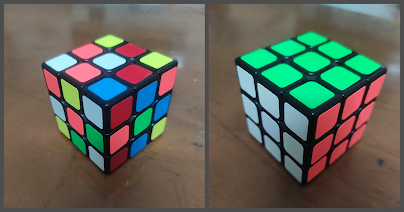When I was in my early teens, I encountered Rubik's Cube for the first time as a birthday gift. Unfortunately, none of my family members knew how to solve the puzzle. Although, with some logical thinking, it was apparent that the cube could be configured by rotating its various layers until each face displayed a single solid color. Despite my random but continuous efforts for several weeks, I couldn't crack it. Eventually, I lost interest, and the Cube went missing, as it is natural for anything out of mind to become out of sight quickly.
Another 2 decades passed, and one of my colleagues, Himanshu, belongs to Gen Z, who recently joined our office, brought a Rubik’s Cube one day. He could configure all faces of the cube in no time. Out of curiosity, I asked him how he could do it so speedily and easily when I had two bad memories of failing in the same task decades ago. He was humble enough to explain that there's a method to it. ⚡
I started learning from him rigorously, and after a month, with 10–15 minutes of daily practice, I finally was able to configure not just 1, but all 6 faces. Even though it took me a good 10 minutes to solve all sides, what mattered most wasn't the time, but the fact that I'd finally learned how to solve the Rubik’s Cube after 40 years.
Some people master it in just 2 days, and with practice, many youngsters can even solve it in under a minute or two. I stand at 10 minutes. It doesn't matter. I'm not competing with anyone. What's important is that I finally learned.
✅5 key lessons emerged from my experience: 👇
💎First, learning has no age restriction. It's never too late to learn or acquire new skills and improve. Some people learn swimming or driving very late in their lives, but what matters is that you attempt, no matter what your age is.
💎Second, everyone is in their own time zone and has their own pace, so never fret over someone else's achievements. Individual progress matters. Focus on your own improvement and growth, rather than measuring yourself against others.
💎Third, persistence with patience is the key. Curiously enough, I asked Himanshu to tell me all the steps involved in configuring the Rubik's Cube. Instead, he advised me to focus on one step at a time and practice that move for at least a week, repeating it at least 100 times daily. I was asked not to pay attention to the end result but to practice one move at a time repeatedly. It was quite frustrating, but later I realized how important it is to master each step involved.
💎Fourth, having a mentor to teach you the right techniques is crucial. Instead of giving up after failed attempts, learn from those who have succeeded. If someone else can do it, so can you, once you've learned the process from the expert. Furthermore, believing there's only one way to accomplish something, we inadvertently limit ourselves from exploring alternative approaches or seeking professional guidance.
💎Fifth, see problems as opportunities to learn. Instead of thinking the Rubik's Cube was too tough, I saw it as a chance to learn something new this time. So, whenever you face a tough task, remember, it's just another chance to learn and improve! Now I realize how easy it is to configure a Rubik’s Cube in just a few minutes, not in decades.
There is nothing called easy or tough in life if you know how to face and solve it! . 📌️
And if you don’t know, always
seek help from the Master! 🔔

No comments:
Post a Comment